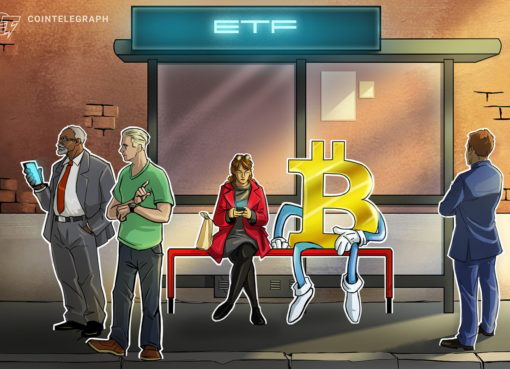Following the recent moves in GameStop (GME) and AMC (AMC) stocks, and DOGE and XRP tokens, investors across the globe are rightfully questioning fundamental investment analysis. While cryptocurrencies are often heralded as a gambler’s playground, the irony is that digital assets might be one of the few asset classes left for true fundamental investment analysis.
Jeff Dorman, a CryptoX columnist, is chief investment officer at Arca, where he leads the investment committee and is responsible for portfolio sizing and risk management.
Ideas are a dime a dozen. What separates good investments from bad investments is how you express those ideas to maximize upside and minimize downside. For example, in 2011-2012, many very smart investors looked for ways to express the same idea: that there was going to be a double-dip recession and inflation was going to be rampant after unprecedented monetary policy interjections (of course, the 2009 stimulus was child’s play compared to the reckless government spending today, but 10 years ago, stimulus was a big deal).
What tools did most investors use to express this view?
- Shorting U.S. equities (into a 10-year bull run)
- Shorting Spanish, Italian and Greek government bonds (yields are now at or below 0% after the European Central Bank essentially nationalized these countries’ debts over the past decade)
- Buying gold (which traded straight down and then sideways for seven years before catching a renewed bid post-COVID)
- Moving teams of distressed analysts to Europe to buy European bank debt that should in theory be offered by these distressed banks at pennies on the dollar (this didn’t work, as the banks simply kept this debt at par value on their balance sheet, and never ended up selling)
As you can probably imagine, none of these investments worked, even though the idea was sound. In fact, one of the best investments to take advantage of the monetary policy and recession theme turned out to be buying bitcoin. Unfortunately for most investors, this instrument wasn’t in their playbook yet.
Most uninformed investors still believe all digital assets are a copycat version of bitcoin and other cryptocurrency, but the reality is today’s digital assets investable universe is very diverse, unique and idiosyncratic. As such, the playbook has expanded, and so have the investable themes that an investor can express. For example, if you wanted to express that the Coinbase initial public offering (IPO) is going to go up 100% upon listing, there are a variety of ways in which you can express that view:
- Buy private Coinbase shares in the secondary market
- Buy shares of similar publicly traded companies (Galaxy, Voyageur, etc.) which should benefit from relative value
- Buy tokens of other exchanges (BNB, FTT, VGX, etc.) which should reprice after the Coinbase S-1 gives details as to how the company generates revenue
- Buy bitcoin or ethereum as a market proxy to represent renewed interest in digital assets.
Not all of these investments will necessarily work. But the point is, coming up with the idea itself is less important than finding the best way to express that view. Paul Tudor Jones’ bitcoin investment thesis back in 2Q 2020 is a good example of this thought process, as it wasn’t a bitcoin investment thesis at all. It was an inflation thesis. Bitcoin was just one of four ways Tudor chose to express this view (the others being a) long the Nasdaq 100, b) long gold and c) buying a 2s/10s Treasury steepener.
Another good example is the recent MicroStrategy (MSTR) convertible bond offering. Given a high cash balance and no other debt in the capital structure, this bond has a very low likelihood of default or impairment. If you bought this convertible note at par, you were effectively being paid 0.75% per year in interest to own a long-dated bitcoin call option. If you were bullish on bitcoin, this was a very cheap and low risk way to express that view.
At Arca, we do fundamental research on the digital assets space. That means, we create an overall top-down view of higher-level theses and macro themes that should create long-term growth, then canvass the universe for investable assets that best express these views and then do a bottoms-up analysis on each individual token, stock or bond to ensure that it will accrue value if we are right.
See also: Jeff Dorman – What This Digital Asset Investment Firm Missed and Capitalized On in 2020
Each investment will have different risk/reward setups, different timeframes to measure success/failure and different total return outcomes. An investment that has just 10% upside but carries only 2% downside may be a better investment from a risk/reward standpoint than an investment that has 1000% upside but also carries 50% of downside risk. The goal is to find the most upside potential per unit of potential downside risk.
While perhaps surprising to many, digital assets offer a variety of ways to structure these investment setups, where fundamental analysis can be used to estimate both downside floors and upside potential. The digital assets ecosystem has evolved into a complex asset class and has become perhaps the perfect asset class for fundamental analysis and low-risk, high-reward investing. In addition to simply finding growth assets, there are now great risk/reward setups that often materialize organically. For example:
Are you interested in expressing a view on the growth of digital assets?
If so, there are protocols that are growing volumes and revenues over 100% quarter over quarter, while also spitting off hundreds of millions of dollars of free cash flow. Uniswap (UNI) and Sushiswap (SUSHI) are the clear market leaders in decentralized exchange (DEX) trading, with annualized revenues of over $500 million and $200mm, respectively. While the UNI and SUSHI tokens have uncertain fates in terms of how value from these cash flows will accrue to the tokens, you can still make a strong fundamental argument. For example, the price-to-sales ratio based on forward revenues is under 5x, which is incredibly cheap relative to equity prices of traditional exchanges, which trade on average between 10-20x, and don’t have the same exponential growth potential. It’s not often that you can invest in a blue chip growth asset that is also a value asset at the same time.
Are you interested in buying ethereum with a very cheap perpetual call option on the growth of DeFi attached?
Because that’s exactly what the wrapped nexus mutual (WNXM) token offers. The NXM token is an asset-backed token, backed by the ETH in the capital pool that is used to pay out potential insurance claims. Based on the amount of ETH currently in the capital pool, the net market cap of nexus mutual (in excess of the assets backing it) is only $43 million, and WNXM trades at only 1.2x book value, even though nexus mutual is a cash flow producing entity with very strong growth metrics. Comparable insurance companies in the public equity market trade at 2-5x book value, with high-growth companies like Lemonade and Root trading closer to 50x book value. At one point, you could even have owned WNXM below book value! Owning WNXM is one cheap way to invest in the growth of the Ethereum blockchain and DeFi.
Would you be interested in buying bitcoin at a 47% discount to current trading levels?
While this one has a lot more hair on it and it will take longer to extract the value, buying EOS might be the cheapest way to buy bitcoin right now. The company behind EOS has at least 140,000 BTC ($5 billion) on its balance sheet, while EOS trades at under $3 billion in market cap. This means buying EOS is like buying bitcoin at a 47% discount if you’re able to extract this value.
The list goes on and on but the point is fundamental investment analysis can and is being utilized in this growing asset class. Cash-flow analysis and book value analysis are just a few tools we use to analyze and value these instruments. Much like fixed income, every digital asset is unique and has different properties and attributes that create value. Our job as fundamental analysts is to find and extract this value, and to do so in the least risky way possible. In our view, finding upside is not nearly as important as limiting the expected downside.
See also: Jeff Dorman – Digital Assets Are More Recession-Proof Than You Might Think
We often find that today’s digital assets investors are impatient or have a singular view. In a world of common 50%-100% weekly returns, many want and expect immediate results and gratification. Therefore, anything that doesn’t go up right away must be wrong or must carry too high of an opportunity cost to warrant an investment. We find that to be very short-sighted. Every investor, and every investment, has a different mandate and certain investment setups fit different buckets. We approach investing in digital assets from a value lens, and we believe there is a lot of value in this space when you look beyond charts and volatility.
Disclaimer: Arca maintains positions in BTC, BNB, FTT, NXM, EOS, UNI, SUSHI, ETH as of the date of this writing. This information is not intended to be investment advice and should not be construed as such. Past performance is not an indicator of future results. All investing involves the risk of loss, including the risk of loss of principal.




